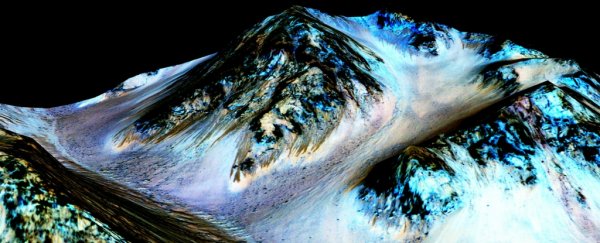NASA told us it was announcing something big today, and it's certainly come up with the goods: the space agency says images from the Mars Reconnaissance Orbiter (MRO) have revealed compelling evidence of liquid brines flowing across the planet's surface. The seasonal rivers of salty water mean there's a greater chance of Mars being able to support life now or in the future.
As far as space exploration goes, it's one of the most significant and historical announcements in many years, but it's not completely unexpected. NASA scientists have known for some time about the appearance of gullies or dark streaks on the surface of Mars during warmer weather - while it was suspected that trickling water was the cause, the new evidence means NASA is now almost certain.
What's changed is that the agency's scientists have managed to identify and track hydrated salts in these gullies - using an image spectrometer on the MRO, the NASA team has been able to link these salts to areas where the slope gullies (or "linae") are at their largest, and that's the evidence they needed to suggest flowing water is the cause. What's more, they've proved that this activity is still happening today, rather than being a remnant of something that occurred in the past.
According to the new model put together by the space agency, the summer months on Mars see a shallow subsurface flow of briny water coming down from the planet's canyons and crater walls. They appear in various spots on the surface when the temperature reaches about minus 23 degrees Celsius (10 degrees Fahrenheit) and then fade in colder conditions. The next mystery to solve is where exactly this water flow is coming from - it could be bubbling up from underneath the crust, or it could be created by some kind of condensation process in the atmosphere of Mars.
"Our quest on Mars has been to 'follow the water' in our search for life in the universe, and now we have convincing science that validates what we've long suspected," said NASA's John Grunsfeld in a press statement. "This is a significant development, as it appears to confirm that water - albeit briny - is flowing today on the surface of Mars."
Perhaps the biggest potential consequence of the discovery is that visitors to the Red Planet could use the water that's hidden away to support themselves and grow food. If scientists can work out where the water is being stored or formed, then these sites would be prime candidates for landing spots on the first manned mission to the planet.
"Of all the worlds we've explored, water flows only on the surface of one - ours - which is why the discovery that water is now likely to be regularly flowing across Mars is so stunning," commented Alan Duffy, a Research Fellow at Swinburne University of Technology in Australia. "The brine on Mars might not directly support life but it suggests that the arid world isn't as dry as once thought. We can't tell if there's life there yet but these dark streaks can tell us where to search in future."
